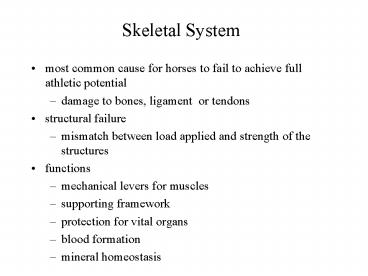Skeletal System - PowerPoint PPT Presentation
1 / 19
Title:
Skeletal System
Description:
Skeletal System. most common cause for horses to fail to achieve full athletic potential ... pony foals. 1-3 line driving, driving in light cart ... – PowerPoint PPT presentation
Number of Views:42
Avg rating:3.0/5.0
Title: Skeletal System
1
Skeletal System
- most common cause for horses to fail to achieve
full athletic potential - damage to bones, ligament or tendons
- structural failure
- mismatch between load applied and strength of the
structures - functions
- mechanical levers for muscles
- supporting framework
- protection for vital organs
- blood formation
- mineral homeostasis
2
(No Transcript)
3
Types of Bones
- long bones
- levers, support of weight, and locomotion
- short
- absorb concussion (joints)
- flat
- enclose cavities with vital organs
- irregular
- spinal column (protect CNS)
4
- epiphysis - either extremity of bone
- proximal or distal
- metaphysis - separates epiphysis and diaphysis
- epiphyseal cartilage (growth)
- articular cartilage - cartilage covering
articular surface - diaphysis - shaft of a long bone
- periosteum - fibrous membrane that covers surface
of bone, except at articular cartilage - functions
- increase diameter of bone
- healing of fractures - splints, spavins, ringbone
- endosteum - fibrous membrane that lines the
marrow cavity - bone growth - addition/deletion of tissue at one
of the existing surfaces
5
(No Transcript)
6
- bone changes itself, conforming to stress
- increase or decrease in mass
- osteoblasts - cells form new bone
- new bone produced in weakest areas
- can generate rather than repair and scar
- osteoclasts - resorption of bone cells
- remodeling - active process
- abundant blood vessel supply nutrients, oxygen
and mineralization - modeling - new growth
- storage reservoir for calcium and phosphorous
- physical stress on bone
- hormonal influences
- nutrition
7
- bone strength indicators
- mature - growth plate closure
- cross sectional area
- bone mineral content
- immature bone - minerals deposits approx. 65 of
space - mature bone - mineral 95 of bone
- cannon measurement
- 7 inches for 1000 lbs
- nutritional manipulation or exercise regime
cannot hasten growth or maturity - genetics and breed determine skeletal maturity,
time - conditioning improves bone strength
8
- mechanical forces stimulate change in
weight-bearing bones - exercise
- increases bone strength
- increases mineral deposition
- increases bone mass
- quantity will increase with exercise not
necessarily the quality - mineralization
- rate of mechanical force applied influences
degree of development - consistent running with gradual increase in
distance will increase bone mineral content - occasional exercise has little effect on BMC
9
- Training
- threshold time of 20-30 minutes to stimulate bone
as much as lengthy exercise - warm-up 10-15 minutes
- gradual incremental exercise
- increase ligament, tendons and muscles
- interval training - build but dont overload
- Inactivity
- demineralization - skeleton weightless
- cast of disuse for extended period of time
- excessive use of corticosteroids or stimulous of
natural corticosteroids
10
Forces that Stress Bone
- axial compression (squeezing together directly
down the bone) - axial tension (pulling apart)
- torsion (twisting)
- mineral content - compressive strength
- collagen (connective tissue of bone) - tensile
strength (stretch)
11
- torsion - 1/3 of compressive strength
- abnormal conformation
- angular limb deformities
- rutted ground
- inconsistent composition of the ground surface
- lack of uniformity in cushioning of ground
- caulks or toe grabs
12
Maintenance of bone tissue. 1) Pressure will
stimulate appositional bone growth. 2) Increased
weight-bearing will increase bone thickness and
density of shaft.
Training Effects Increases bone mass and alters
the distribution of the mass, so as to provide
more bone where high strains occur.
13
Biochemical Stress
Stress - force per unit area Strain - degree to
which a bone deforms to the stress
Forces that Stress Bones
Compression and tension Torsion (twisting)
14
- shape of bone will vary
- along shaft
- cortical wall thickness
- pull of tendons, ligaments and muscles
- effect of weight bearing and support of bodymass
- force created from impact of ground
15
Representative example of increasing bone
strength with age and work.
16
Decrease in bone strength with sore shins.
Decreased again after the animals were put back
to work.
17
- 3 months - 1 year
- increase in compressive strength due to increased
BMC - stabilizes at this level until 3 years
- compressive strength improves again until 7 years
- bone failure in young
- dont want excessive exercise
- 70 3 year old race horses develop bucked shins
- eventual overload - stress fracture
18
Increased Risk for Bone Failure
- weight-bearing stress
- longing- even in big circles
- twisting bones and immature joints
- jumping young
- radically overloads limbs
- long distance work - esp at high speeds
19
Early Training
- do not pen or stall foals
- pony foals
- 1-3 line driving, driving in light cart
- 3-4 weight-bearing, big circles, increase
duration and distance, speed training after
foundation is set































